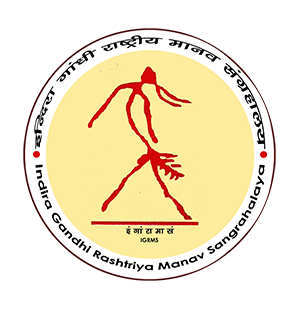भोटिया
जिला: चमोली, उत्तराखण्ड
संकलन वर्ष : 2011
भोटिया जनजाति का पारंपरिक आवास
मनुष्य की मूल आवश्यकताओं में से एक आवास विकास की आरंभिक अवस्थाओं से आज पर्यन्त मानवीय सूझबूझ ज्ञान और कौशल की एक वैविध्यपूर्ण और अनूठी भौतिक अभिव्यक्ति है जो स्थान] काल और पारिस्थितिकी के साथ तालमेल की उसकी विलक्षण क्षमता को व्यक्त करता है।
इंदिरा गांधी राष्ट्रीय मानव संग्रहालय की हिमालय ग्राम मुक्ताकाश प्रदर्शनी में सुदूर हिमालयीन राज्यों से संकलित कर पुर्नस्थापित किये गये आवास प्रकारों के बेजोड नमूने इसका उदाहरण है। आनलाईन प्रदर्शनी श्रंखला की यह कडी इन्हीं में से एक भोटिया आवास के अवलोकन को समर्पित है। उत्तराखण्ड के पर्वतीय आवासों में आकारीय भिन्नता के अनुसार आवास प्रकारों की एक परम्परा रही है जिनके विभिन्न नाम भी हैं।
उत्तराखण्ड के जिला चमोली के सीमान्त क्षेत्र में बसे हुए भोटिया जनजाति के लोगों द्वारा बनाये जाने वाले मकान अधिकांशतः एक या दो मंजिला होते है जो पत्थर एवं लकडी से बनाये जाते है। अत्यंत बर्फबारी होने के कारण मकान की ऊंचाई कम होती है। इसकी दीवारों पर गोबर एवं मिट्टी से पुताई की जाती है। यह मिट्टी विशेष प्रकार की होती है जिसे स्थानीय भाषा में चोपडमाटू कहते हैं। प्रत्येक वर्ष एक बार इसी मिटटी से पुताई की जाती है जिसे छिपटण कहा जाता है। इससे आवास की मजबूती एवं सौंदर्य बना रहता है। आवास में अधिकतर स्थानीय देवदार की लकडी का प्रयोग होता है। आवास की छत में देवदार की लकडी के लगाये जाते हैं। चूंकि यहां बर्फबारी अधिक होती है जिसका भार ये पट्टे सहन कर लेते हैं। फर्श में भी लकडी के ही पट्टे लगाये जाते हैं जिसे बासा कहा जाता है। पहली मंजिल पर सामने की ओर बाहर निकला हुआ हिस्सा होता है इसे त्येबारी कहा जाता है। ऊपर के कमरों को पांडा तथा नीचे के कमरों को ओबरा कहा जाता है। लगभर हर घर के मुख्य द्वार पर भगवान गणेश की प्रतिमा लगी जाती है।
भोटिया आवास की मुख्य विशेषता इसके निर्माण में सामुदायिक सहभागिता है। देवताओं के स्थान तथा ग्रामवासियों की सामूहिक आवास कभी भी एकाकी रूप से निर्मित नहीं होते बल्कि उसके लिये जंगल से लकडी लाने और निर्माण की विभिन्न प्रक्रियाओं को आपसी सहयोग से पूर्ण किया जाता है आवास की भव्यता और सुंदरता ही आपसी सौहार्द और भाईचारे का प्रतीक है।
वृक्षों की कटाई से हो रहे पर्यावरण क्षरण को देखते हुए घरों का निर्माण अब असंभव हो गया है। इस अर्थ में गांव के आवास अब अमूल्य धरोहर बन गये हैं। आदिकाल से प्रारंभ हुई आवास निर्माण की कला आज विलुप्त होने की कगार पर है। संग्रहालय द्वारा वर्ष 2012 में संकलित यह आवास जिला चमोली के कलाकारों के द्वारा संग्रहालय की हिमालय ग्राम नामक प्रदर्शनी में निर्मित किया गया है।
Bhotia
District: Chamoli, Uttarakhand
Year of collection: 2011
Traditional dwelling of Bhotia tribe
The house one of the basic needs of humankind right from the very early stages of development till today is a unique and diversified manifestation of human intelligence, wisdom and skill which reflects its distinct adaptation with time, space and ecology.
Amazing samples of house types collected from remote Himalayan states and installation in the Himalayan Village Open Air Exhibition of the Indira Gandhi Rashtriya Manav Sangrahalaya, Bhopal are the best example of the same. This episode of online open air exhibition series is dedicated to observation of one of these dwellings.
In the hilly region of Uttarakhand, there has been a tradition of housing patterns and their names according to the morphological variations. Houses of the Bhotia tribal settled in border areas of the Chamoli district of Uttrakhand are usually single or double storied made of stone and wood. Because of the heavy snowfall in the region, height of house is low. Walls of the house are painted with mud and cowdung. This is a special type of soil called ‘Choppad Matoo’ in local dialect. The process of applying Choppad Matoo on wall is called ‘Chhiptar’ which is done once in a year. It strengthens the walls and maintains the beauty. Local Cedar wood is used in these houses. Roof of the house is made of wide rafters of cedar wood which bear the load of heavy snowfall. Flooring is also done with wooden planks called ‘basa’. The first floor has an extended elevation called ‘Tyebari’. Rooms on upstairs are called ‘Pada’ whereas rooms on ground floor are called ‘obra’. Idol of Ganesha is installed at the entrance of every house.
Community participation in construction is the main characteristic of Bhotia dwelling. Be it a shrine or a common dwelling for villagers never built alone instead various processes of building house right from collecting wood from jungle and so on are accomplished with mutual co-operation. Grandeur and beauty of the house symbolizes the harmony and brotherhood in the community.
Due to environmental degradation caused by deforestation, construction of such houses has been impossible. In such a way these rural habitats have become an invaluable heritage. The age old art of constructing such houses is on verge of extinction. Collected by the museum in year 2012, this house type was constructed by the artists from Chamoli in the Himalayan Village Open Air Exhibition of the Museum.



